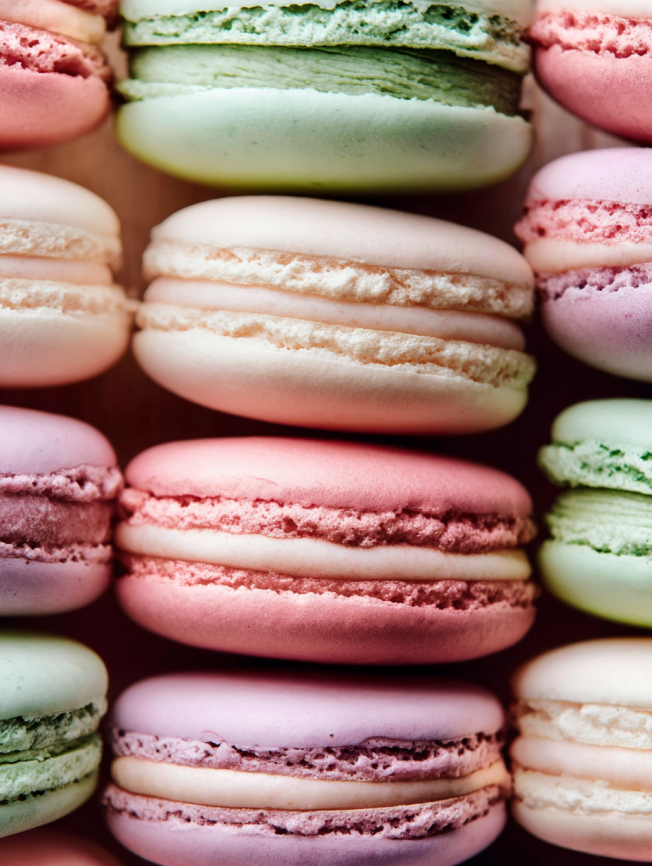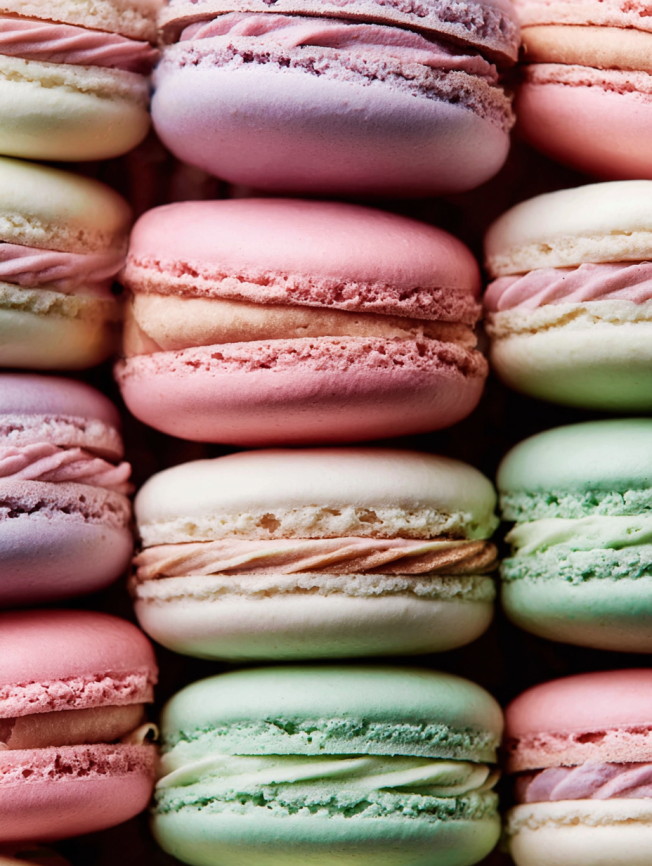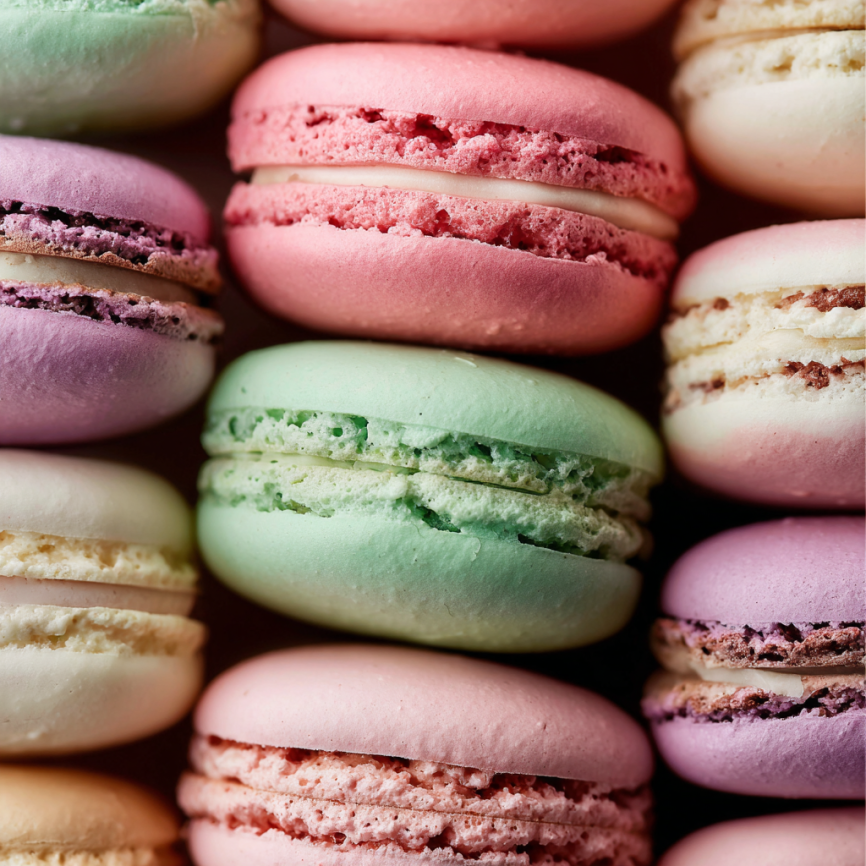Prep Time: 1 hour (plus aging egg whites) | Cook Time: 13 minutes | Total Time: 1 hour 30 minutes | Yield: About 40 shells; 20 sandwiched macarons
From Intimidating to Irresistible
For years, I avoided making French macarons, convinced they were beyond my capabilities as a home baker. These delicate sandwich cookies seemed to exist in a realm reserved for professional pastry chefs, with their perfectly smooth tops, signature ruffled feet, and endless potential for failure. However, after countless attempts and careful attention to technique, I discovered that macarons are absolutely achievable in a home kitchen.
The moment I pulled my first successful batch from the oven – complete with those coveted feet and glossy shells – I felt an incredible sense of accomplishment. These aren’t just cookies; they’re edible art that transforms simple ingredients into something truly spectacular. Moreover, once you master the basic technique, the creative possibilities for flavors and fillings become endless.
Why These Macarons Will Change Your Baking Game
Precision Breeds Perfection
Unlike many baking recipes that forgive small variations, macarons demand accuracy and reward it with stunning results. This precision teaches valuable techniques that will elevate all your future baking endeavors. Furthermore, the methodical approach builds confidence and understanding of how ingredients interact.
Endless Creative Potential
The neutral almond base serves as a perfect canvas for any flavor profile you can imagine. Whether you prefer classic vanilla or adventurous combinations like lavender honey or salted caramel, these shells accommodate every creative vision beautifully.
Impressive Presentation
Few homemade treats create the same “wow factor” as perfectly executed macarons. They instantly elevate any dessert table and make thoughtful gifts that showcase your baking skills. Additionally, their elegant appearance belies their surprisingly simple ingredient list.
Essential Ingredients
For the Macaron Shells
- 100g egg whites (typically 3-4 large egg whites)
- ¼ teaspoon (1g) cream of tartar
- ½ teaspoon extract (vanilla, almond, coconut – optional)
- 80g superfine sugar (also called caster sugar)
- 1-2 drops gel food coloring (optional)
- 125g almond flour (fine, not almond meal)
- 125g confectioners’ sugar
Filling Options
- Vanilla buttercream (half batch recommended)
- Chocolate ganache (cooled and thickened)
- Fruit preserves or lemon curd
- Cream cheese frosting
- Salted caramel (cooled)
Precision is crucial – invest in a kitchen scale for guaranteed success with these measurements.
Step-by-Step Instructions
Preparation Phase
Step 1: Begin 24 hours ahead by wiping down a large glass or metal mixing bowl with lemon juice or vinegar. Add the egg whites, cover, and refrigerate for 24 hours. This aging process helps create more stable meringue.
Step 2: Remove aged egg whites from refrigerator and bring to room temperature. Meanwhile, line three large baking sheets with silicone baking mats or parchment paper.
Creating Perfect Meringue
Step 3: Add cream of tartar and extract (if using) to the room temperature egg whites. Using a handheld or stand mixer with whisk attachment, beat on medium speed until very soft peaks form. The mixture will start foamy, then tighten as volume builds.
Step 4: Gradually add the superfine sugar in three additions. Add the first third, beat for 5 seconds, then add the second third while the mixer runs. Beat for 5 seconds, add the remaining sugar, and continue beating until stiff, glossy peaks form.
Step 5: Test for proper consistency by turning the bowl upside down – the meringue should not move or fall out. Using a rubber spatula, gently fold in food coloring if desired.
Preparing the Dry Ingredients
Step 6: Sift the almond flour and confectioners’ sugar together in a large glass or metal bowl. Use a spoon to work any larger pieces through the sieve, as you need all the ingredients for proper batter consistency.
The Critical Macaronage Technique
Step 7: Fold the meringue into the almond flour mixture in three separate additions. After incorporating all the meringue, continue folding until the batter reaches honey-like consistency.
Step 8: Perform the figure-8 test: drop batter from your spatula in a figure-8 pattern. If it takes more than 10 seconds to sink back into itself, continue folding. If it takes less than 10 seconds, the batter may be overmixed.
Piping and Setting
Step 9: Transfer batter to a piping bag fitted with a medium round tip (Wilton 12, 1A, or Ateco 806). Hold the bag at a 90-degree angle and pipe 1.5-2 inch rounds, spacing them 1-2 inches apart.
Step 10: Bang the pans firmly on the counter several times to release air bubbles. Use a toothpick to pop any remaining visible bubbles on the surface.
The Crucial Resting Period
Step 11: Allow piped macarons to sit at room temperature for 30-60 minutes until they’re no longer tacky to gentle touch. This forms the essential skin that creates the signature feet during baking.
Baking to Perfection
Step 12: Preheat oven to 325°F (163°C) during the resting period. Bake for 13 minutes, watching for the formation of feet around the base of each shell.
Step 13: Test doneness by gently touching the top of a macaron. If it feels wobbly, bake for another 1-2 minutes. When properly done, the shells should feel set and stable.
Cooling and Assembly
Step 14: Cool shells on the baking sheet for 15 minutes before transferring to a wire rack. Attempting to remove them too early may cause sticking or breakage.
Step 15: Once completely cool, match shells by size and sandwich together with your chosen filling. Use a knife to spread or pipe the filling using the same tip used for the shells.

Serving Suggestions
Fresh macarons are delightful immediately after assembly, but many professionals recommend aging them in the refrigerator for 12-24 hours to allow flavors to meld and textures to mature. Serve at room temperature for the best texture and flavor experience.
Create elegant presentations by arranging different colors and flavors on tiered stands or in decorative boxes. They make stunning additions to afternoon tea service, wedding dessert tables, or as sophisticated party favors. Consider seasonal color schemes or flavor combinations that complement your event’s theme.
Creative Flavor Variations
Classic Combinations
Traditional vanilla shells pair beautifully with raspberry jam, chocolate ganache, or lemon curd. These timeless combinations showcase the delicate almond flavor while providing complementary tastes and textures.
Seasonal Specialties
During autumn, try pumpkin spice shells with cream cheese filling, or create festive holiday versions with peppermint extract and chocolate ganache. Spring celebrations call for lavender shells with honey buttercream or strawberry-filled pink shells.
Gourmet Adventures
Experiment with sophisticated flavors like Earl Grey shells with bergamot buttercream, or coffee-flavored shells with salted caramel filling. Matcha powder creates beautiful green shells that pair wonderfully with white chocolate ganache.
Make-Ahead Strategies
Advance Planning
Macaron shells can be baked and stored unfilled in airtight containers at room temperature for up to one week. This makes them perfect for entertaining, as you can prepare shells ahead and fill them the day of serving.
Freezing Guidelines
Both unfilled shells and completed macarons freeze exceptionally well for up to one month. Freeze shells in single layers with parchment between layers, then transfer to freezer bags. Assembled macarons should be frozen in rigid containers to prevent crushing.
Assembly Timing
For best results, fill macarons no more than 24 hours before serving. The filling will gradually soften the shells, creating the perfect chewy texture that makes macarons so special.
Professional Success Tips
Ingredient Quality Matters
Use fine almond flour specifically, not almond meal. Almond flour is made from blanched, skinless almonds and ground to a much finer consistency. Almond meal contains skins and has a coarser texture that can prevent smooth shells.
Environmental Factors
Humidity significantly affects macaron success. Avoid making them on very humid days, and ensure your kitchen is relatively dry. If necessary, use a dehumidifier or air conditioning to create optimal conditions.
Equipment Essentials
A kitchen scale is absolutely crucial for consistent results. Weight measurements are far more accurate than volume measurements for these delicate cookies. Additionally, ensure all equipment is completely clean and grease-free.
Temperature Control
Room temperature egg whites whip more easily and create more stable meringue. If you forget to bring them to room temperature, place the bowl in warm (not hot) water for a few minutes, stirring occasionally.
Troubleshooting Common Issues
Problem: Macarons have no feet or cracked tops Solution: This usually indicates insufficient resting time before baking, oven temperature too high, or improper meringue consistency. Ensure shells are completely dry to touch before baking.
Problem: Shells are lopsided or hollow Solution: Overmixed batter is the most common cause. The figure-8 test helps prevent this – stop folding as soon as the batter passes this test.
Problem: Macarons stick to parchment or mats Solution: Underbaking is typically the culprit. Ensure shells don’t wiggle when gently touched before removing from oven. Cool completely on the pan before attempting removal.
Problem: Filling leaks out or makes shells soggy Solution: Use less filling, or choose thicker consistencies like buttercream over thin ganache. Also, avoid overfilling the shells.

Frequently Asked Questions
Q: Can I make macarons without aging the egg whites? A: While aging isn’t absolutely required, it significantly improves success rates by reducing moisture content and creating more stable meringue. Fresh egg whites from the shell work better than carton egg whites.
Q: Why do my macarons have bumpy or wrinkled surfaces? A: This usually results from insufficient sifting of dry ingredients, air bubbles not properly removed, or uneven oven temperature. Ensure thorough sifting and bang pans firmly after piping.
Q: Can I use liquid food coloring? A: No, liquid coloring will affect the batter consistency and likely cause failure. Use only gel or powder food coloring, and use it very sparingly – 1-2 drops maximum.
Q: How do I know if my meringue is properly whipped? A: Properly whipped meringue forms stiff, glossy peaks that don’t droop when the whisk is lifted. You should be able to turn the bowl upside down without the meringue moving.
Q: What’s the ideal humidity level for making macarons? A: Humidity below 50% is ideal. Above 60% humidity can prevent proper skin formation and cause various issues. Consider postponing macaron-making on very humid days.
Q: Can I make different flavored shells in the same batch? A: It’s better to make one flavor per batch to ensure consistency. However, you can divide the finished batter and add different colorings or extracts to separate portions.
Q: How long do filled macarons last? A: Properly stored filled macarons keep in the refrigerator for up to 5 days. The texture actually improves after the first day as the filling softens the shells slightly.

